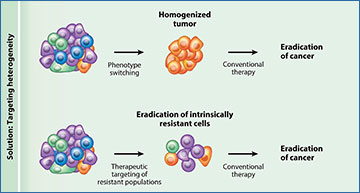From 10X Genomics Blog by Natalya Ortolano
Charles Darwin’s theory of evolution was inspired by the diverse species of finches inhabiting the Galápagos Islands. Darwin’s finches evolved from a species that arrived on the islands millions of years ago. Their most distinctive feature is their diverse variety of beaks, each perfectly suited for their food preferences, the result of centuries of natural selection.
The heterogeneous cells within complex human tumors are like Darwin’s infamous finches on the Galápagos Islands—the most well-adapted survive even the most aggressive treatments. But the effects of natural selection within a tumor can happen seemingly overnight and turn a treatment from promising to ineffective.
Figure 1. Natural selection complicates treatment of highly heterogeneous tumors. Intrinsically resistant cells within a tumor often survive treatment and quickly form a highly treatment-resistant tumor. Effective treatments against heterogeneous tumors must eliminate resistant cells by targeting them before conventional therapy. Treatment strategies include pushing cells to respond via phenotype switching or specifically eliminating resistant cells (Tammela T and Sage J. Annu Rev Cancer Biol 4: 99–119 (2020).).





